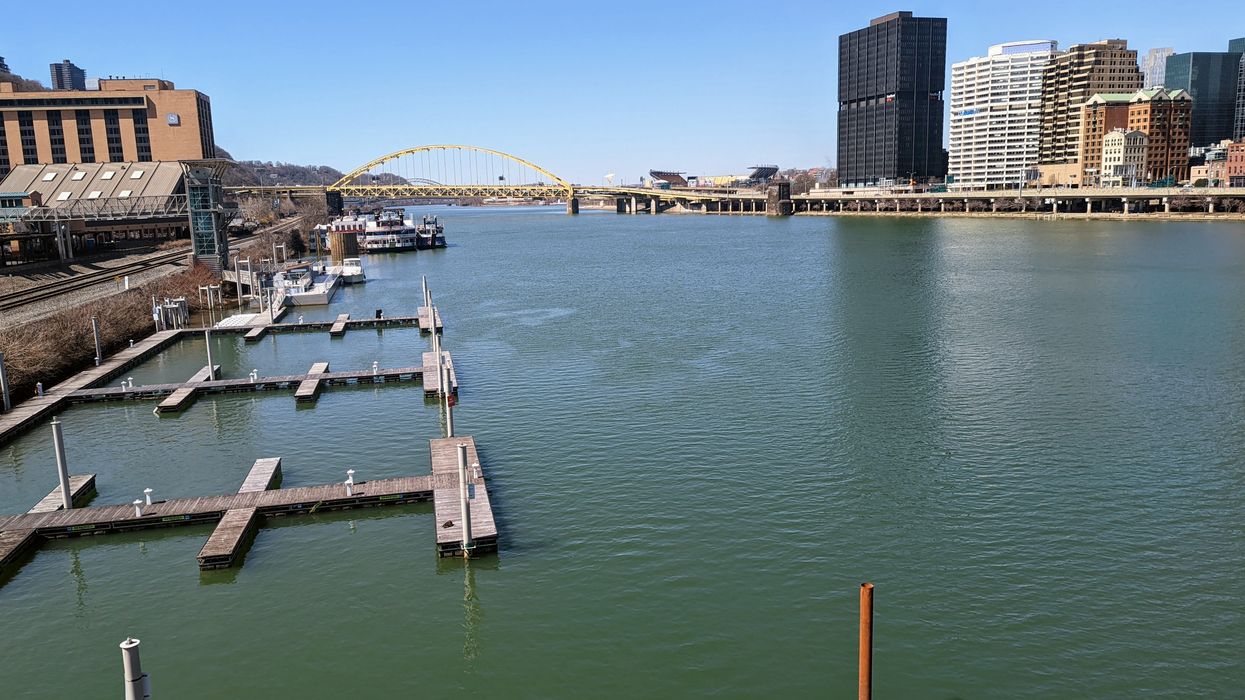
PITTSBURGH — Last month the U.S. Environmental Protection Agency (EPA) announced the first federal regulations for “forever chemicals” in drinking water.
The chemicals, known as per- and polyfluoroalkyl substances or PFAS, are linked to kidney and testicular cancer, liver and thyroid problems, reproductive problems, pregnancy-induced high blood pressure, low birthweight and increased risk of birth defects, among other health effects.
There are nearly 15,000 different PFAS and evidence of the chemicals has been found in everything from carpets and cookware to food wrappers, makeup and bandaids. PFAS don’t break down naturally and have been detected in drinking water at more than 5,000 sites in all 50 states.
The new regulations, among the most protective health limits on PFAS in drinking water in the world, will go into effect on June 25 and set limits for six common PFAS — PFOA, PFOS, PFHxS, PFNA, PFBS and GenX. Many researchers who study these chemicals have called on regulators to restrict these chemicals as a class rather than individually. But because the chemicals build up in our bodies over time, any reduction in exposure is likely to be beneficial for health.
“This is the first time the EPA has issued a rule on water contaminants in 28 years. So this is significant,” Michelle Naccarati-Chapkis, executive director of Women for a Healthy Environment, a nonprofit environmental health advocacy group based in western Pennsylvania, told EHN.
Eleven states, including Pennsylvania, Maine, Massachusetts, Michigan, New Hampshire, New Jersey, New York, Rhode Island, Vermont, Washington and Wisconsin have already adopted their own limits on PFAS in drinking water. The EPA’s new limits are stricter than any existing limits, so states are preparing to meet the new EPA standards.
“PFAS exposures are toxic even at low concentrations,” Naccarati-Chapkis said. “We didn’t think Pennsylvania’s state regulations went far enough, so we’re glad these new federal rules will better protect residents across the Commonwealth.”
What are the new limits and how will they protect our health?
The EPA’s new PFAS limits are 4 parts per trillion (ppt) for PFOA and PFOS and 10 ppt for GenX, PFNA and PFHxS, all of which are newer PFAS that have been less extensively studied than PFOA and PFOS.
The regulations also create a “hazard index” to address combined risks from mixtures of chemicals. For PFNA, GenX, PFHxS and PFBS, water system operators will determine if the combined levels of two or more in drinking water pose a potential risk and require action.
The regulations also consider the levels of PFAS that can be detected by laboratories and the cost and feasibility of removing them. The EPA set “Maximum Contaminant Level Goals” for some PFAS, which represent the limit at which the agency has determined that no adverse health effects would occur.
Whenever the EPA has identified a cancer risk associated with a pollutant, the Maximum Contaminant Level Goal is set to zero, which the agency has applied to PFOA and PFOS. While the Maximum Contaminant Levels of 4 ppt for PFOA and PFOS and 10 ppt for PFHxS, PFNA, and GenX are enforceable, the Maximum Contaminant Level Goals are aspirational.
“Setting those goals to zero is an acknowledgement that there’s basically no safe level of exposure to these chemicals,” Carla Ng, an associate professor and PFAS researcher at the University of Pittsburgh, told EHN.
The Biden administration expects the new regulations to “protect 100 million people from PFAS exposure, prevent tens of thousands of serious illnesses and save lives.”
Additionally, the EPA recently classified PFOA and PFOS, two of the most common PFAS, as “hazardous substances” under the federal Superfund act, which gives the EPA the authority to clean up PFAS contamination and to recover the cost of these cleanups from polluters.
“I think these two pieces are one two-punch,” Ng said. “With both, now we’ll have a way to clean up not only water, but also other mediums like soil. That’s important because PFAS exposure also happens through things like indoor air and contaminated food, and this will allow us to start addressing those exposures too.”
What will this mean for Pennsylvania?

One in three Pennsylvania drinking water systems had detectable levels of PFAS as of 2021. Additionally, PFAS have been detected in 76% of sampled rivers and streams throughout the state, many of which are used for drinking water.
In January 2023, six years after initially pledging to regulate the chemicals, the Pennsylvania Department of Environmental Protection passed limits of 14 ppt for PFOA and 18 ppt PFOS in drinking water. Now, those limits must be tightened.
“Pennsylvania is already working to revise its regulations to align with the federal rulemaking in places where the state rule is less stringent,” PA DEP spokesperson Neil Shader told EHN.
Pennsylvania’s regulations need to be updated within two years of the start date for the new federal rules. The agency plans to help water authorities address any challenges and secure funding.
“DEP will take every step to ensure water authorities in the Commonwealth can meet state and federal limits for PFAS – including increased training and to help local operators understand the new federal rule,” Shader said. “Additionally, [the Pennsylvania Infrastructure Investment Authority] has been able to fund 100% of all requests for the construction and installation of treatment facilities to date and has the financial capacity to address any additional requests for the foreseeable future.”
The EPA also offers assistance programs for water authorities that need help implementing monitoring and treatment of contaminants like PFAS. The Biden’s administration dedicated $9 billion in funding to address PFAS and other emerging contaminants in drinking water through the $1 trillion infrastructure legislation that passed IN 2021, commonly known as theBipartisan Infrastructure Law.
“Pennsylvania is already working to revise its regulations to align with the federal rulemaking in places where the state rule is less stringent.” – Neil Shader, PA DEP spokesperson
The new regulations do not apply to the approximately 2.5 million Pennsylvania residents whose water comes from private wells.
“DEP recommends private residents who choose to test their water use a state-certified laboratory using EPA-approved testing methods,” Shader said, noting that the agency offers a list of accredited laboratories online.
Ng said more resources are needed to help private well owners. “That has always been a big blind spot in Pennsylvania,” she said. “There’s very little protection for people with private wells, and we really need funds to help them do testing and treatment for PFAS and other contaminants as well.”
For some water authorities, including the Pittsburgh Water and Sewer Authority, which provides drinking water to more than 500,000 people, the new rules won’t require many changes.
“We always try to be proactive about looking at emerging contaminants,” Frank Sidari, chief environmental compliance and ethics officer at the Pittsburgh Sewer and Water Authority (PWSA), told EHN. “We’ve been monitoring for PFAS since 2014, so it won’t be too difficult for us to prepare for the new federal regulations.”

So far, Sidari said, the municipal authority’s monitoring hasn’t detected levels of PFAS high enough to prompt removal of the contaminants.
“We always try to be proactive about looking at emerging contaminants. We’ve been monitoring for PFAS since 2014, so it won’t be too difficult for us to prepare for the new federal regulations.” – Frank Sidari, Pittsburgh Sewer and Water Authority
At some smaller water authorities, the new regulations will require a bigger lift. The Wilkinsburg-Penn Joint Water Authority, which serves around 40,000 people in western Pennsylvania, began some voluntary monitoring for a list of 29 PFAS in both drinking water and source water in 2023 in anticipation of new EPA monitoring requirements, but the process is still new.
“This is an extremely complex group of contaminants,” Lou Ammon, manager of purification at the Wilkinsburg-Penn Joint Water Authority, told EHN. “We have not received any resources to date and do not expect to receive any resources for our continued enhanced monitoring.”
While the state’s environmental agency said resources are available for water authorities that reach out to and request help removing PFAS, both Ammon and Sidari said they hadn’t received any outreach from state regulators advertising or offering resources to help with PFAS monitoring or removal.
To date, Ammon said, the Wilkinsburg-Penn Joint Water Authority hasn’t detected PFAS high enough to prompt new treatments, but “if we ever have to treat/remove PFAS from our water during treatment, I have not been informed of what resources we should expect to receive at that time.”
“What I really think we need are regulations and remediation funding sources from businesses and corporations that have profited directly from the manufacture and use of these compounds,” Ammon said.
As of April 2024, attorney generals in 30 states, including Pennsylvania, have initiated lawsuits against manufacturers of PFAS for contaminating water supplies, according to Safer States, a national coalition of environmental health organizations.
“What I really think we need are regulations and remediation funding sources from businesses and corporations that have profited directly from the manufacture and use of these compounds.” – Lou Ammon, Wilkinsburg-Penn Joint Water Authority
Ammon also called for regulation of PFAS in consumer products. Some states have begun banning PFAS in consumer products, but Pennsylvania has not.
“Every day that these direct consumer contamination sources are unregulated is a day that these compounds can be affecting the public’s health or contaminating source water,” Ammon said, “[and] that will ultimately need to be treated and paid for by water treatment plant rate-payers and in federal/state tax dollars, paid by the public.”

